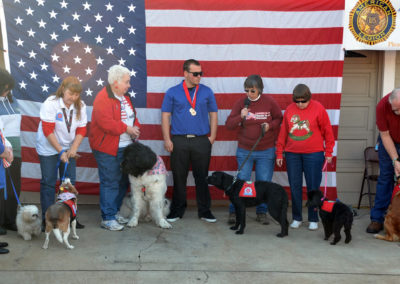Therapy Dogs
How and Why Therapy Dogs Can Help People
Schools and Colleges
- Serve as an uncritical listener when read to which makes students more apt to read
- Encourage students to share things like showing pictures in books to the dog or telling others about their pets at home
- Help students destress before taking tests
- Help calm down disruptive student(s) and get them to behave
- Encourage students to do what teachers and staff ask them to do
- Relax students when they have to speak in front of the class and are too nervous to do it without the dog there
- Give them an opportunity to write stories about and draw pictures of the dogs, and talk about their pets at home
- Encourage participation in group activities, making it easier for students to open up (e.g., they talk more with the dog by them, they play games with their team)
- Promote attendance at special events (e.g., book fair, new school dedication, sports events)
- Give students something to look forward to during recess and lunch
- Help students and staff cope with challenging situations (e.g., death of a student, a popular teacher having to quit for medical reasons)
- Help comfort students being bullied and shows other students that the one being bullied has feelings
- Can help special ed students with a variety of emotional, social, physical and cognitive challenges
- Help students overcome their fear of dogs, even to the point of asking their parents to get a dog
- Bring joy to students and staff too as evidenced by the smiles on their faces and dashing over to see the dog and touch it
Veterans and Troops
- Comfort them as they cope with memories of times in the service
- Show them how much we appreciate what they do for our country
- When sending bookmarks in pack outs to troops overseas, help them recall pleasant memories of times with their pets at home
- Calm them down when stressed by current situations
- Bring laughter and relaxation at public military events such as welcome homes and parades
- Can serve as an ice-breaker and encourage a veteran to open up and talk about experiences and feelings
Health and Care Facilities
- Provide a friend they can talk to and who listens to them
- Encourage people to reach out and touch them, to move their hands, and to talk to the dog
- Help reduce stress and improve blood pressure for patients, residents, and staff
- Encourage people to follow the instructions of staff
- Motivate people to participate in activities
- Help family and friends feel more comfortable when visiting loved ones
- Comfort people as they grieve over the loss of a loved one
- Reduce pain because touching a dog releases endorphins
- Show everyone they are loved by providing warmth and comfort and releasing oxytocin as they touch the dog
- Distract people when they are doing something they shouldn’t
- Slow down rapid breathing, spasms, seizures, etc.
- Increase the likelihood of therapy being effective by encouraging people to do their best, to open up and talk, to say commands to the dog during speech therapy, by helping them learn how to use a walker, by encouraging people to follow the dog, and more
- Encourage people to be patient when they want attention from staff right away
- Give people something to look forward to—the next visit with a therapy dog
How to Get Involved
If you would like to become a therapy dog handler or are interested in having therapy dogs visit your facility or program, contact:
Alliance of Therapy Dogs
P.O. Box 20227
Cheyenne, WY 82003
877-843-7364
therapydogsinc@qwestoffice.net
www.therapydogs.com
ATD Inc. will refer your inquiry to Patricia Wheeler, or someone else who can respond to it.
The Books
- Musical Laughs: Notes to Brighten Up Your Day
- Amazon, the Golden Eagle: Her Story of Overcoming a Tough Start
- Successful Tails: The Wonders of Therapy Dogs
- Therapy Dogs in Action: Their Stories of Service and Love
Why Therapy Dogs?
Therapy dog sessions are helpful in schools and colleges, health care facilities, in programs for troops and veterans, and in other organizations.
Resources
Links to Pat's favorite organizations.












